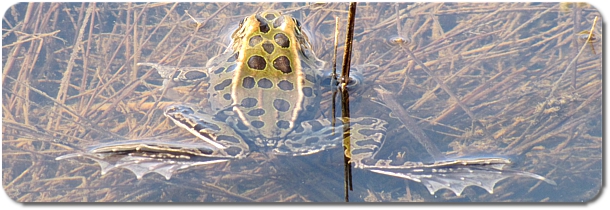Northern Leopard Frog

What it looks like
The Northern Leopard Frog is a large frog. The body can be as long as 11 cm. With legs stretched out it can be 30 cm from the mouth to the tip of the toes.
Northern Leopard Frogs can be different colours. They can be light or dark green or sometimes light brown. They have lots of dark spots and a white belly.
Look-alikes
A Mink Frog, Green Frog or Wood Frog could look like a Northern Leopard Frog. None of these has the big dark spots that a Leopard Frog has. The Mink and Green Frogs are only found in southeastern Manitoba around Whiteshell and Nopiming Provincial Parks. Wood Frogs are brown with a dark triangle under the eye.
Name
The Northern Leopard Frog gets its name because it has spots like a leopard. There are different kinds of Leopard Frogs in North America. Ours is the one that lives farthest north.
Scientific Name
The Northern Leopard Frog's scientific name is Lithobates pipiens. Learn what that means on this page: Scientific Names.
Where it lives
Northern Leopard Frogs live near wetlands. They can be found near lakes, streams, rivers and marshes. Sometimes they move into grasslands or forests far away from wetlands. They are found across the centre of North America and in most parts of Manitoba, except in the far north.
Where Northern Leopard Frogs live in North America.
Habits
Northern Leopard Frogs spend most of the time hiding in thick grass or other plants waiting for prey to come by. They are active and hunt all day long. In summer these frogs will move far away from wetlands to look for food, but come back to the water's edge by fall. They spend winter on the bottom of ponds, rivers or lakes that do not freeze to the bottom.
Food web
Northern Leopard Frogs eat many kinds of invertebrates such as insects, spiders, worms, crayfish and snails. They will eat other small frogs, and sometimes young snakes, small mice and baby birds!
Lots of animals will eat Leopard Frogs and their tadpoles. Snakes are their main enemies on land. Turtles will catch frogs and tadpoles in the water. Mammals like raccoons, skunks, mink and otters will eat them, too. Many birds eat Northern Leopard Frogs and their tadpoles. Herons, crows, hawks and even owls will make a meal of one.
Life cycle
Leopard Frogs breed from April to late May. Males gather together in ponds, marshes, streams or small lakes to call and attract females.
| Hear the Leopard Frog mating call: | |
| With some Spring Peepers, too. | |
Each female can lay more than 1,000 eggs in one big clump attached to some floating plants or sticks. The eggs hatch in about one week. The tadpoles grow quickly and may change into froglets by late July or early August, after about 60 to 80 days as tadpoles. A tadpole may grow to be 8 cm long. New froglets can be about 3 cm long.
Numbers
Northern Leopard Frogs are common in Manitoba. There can be as many as 100 Leopard Frogs in every hectare near a wetland.
In the 1970's a sickness spread through North America and killed almost all of our Leopard Frogs. In the 1990's the Leopard Frog started to become common again.
Special things
The Northern Leopard Frog is the largest frog in Manitoba. Its green colour and dark spots help it to hide among the plants near wetlands. Its big webbed feet help it to jump on land and swim in water.

Look at those hind feet!
How to find Northern Leopard Frogs
Northern Leopard Frogs can be seen near wetlands and in grasslands or forests near wetlands. In spring you can listen for calling males near wetlands. Evening is the best time to hear them, but they will call during the day, too.
Use by people
Before the 1970's, when most of our Northern Leopard Frogs died, people used to make money by collecting and selling them. Most of these were used in biology classes for dissection. People still use them today as bait to catch fish. Some people eat Northern Leopard Frogs as "frog legs"!
| Next frog: Mink Frog | Back to: Amphibians and Reptiles Front Page |
